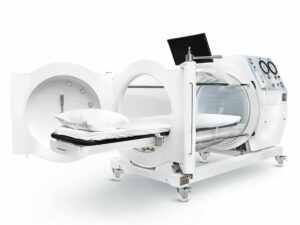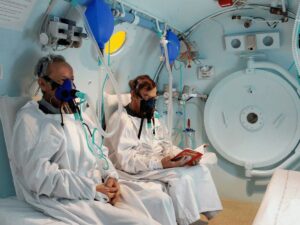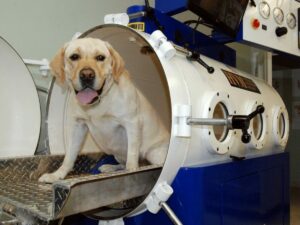Are your recovery solutions keeping pace with industry advancements? Hyperbaric chambers, a cutting-edge technology, offer a fascinating approach to healing and rejuvenation.
With years of experience in the field and a deep understanding of hyperbaric technology, my insights aim to shed light on how these devices can make a substantial difference.
Hyperbaric chambers stand as a critical asset for recovery, optimizing outcomes with their unique approach to wound healing and rehabilitation.
In this guide, you’ll discover the science behind hyperbaric chamber, explore various chamber models, and learn how they can be integrated into recovery protocols.
Dive right in and discover the potential!
1. Overview of Hyperbaric Oxygen Therapy
Hyperbaric Oxygen Therapy (HBOT) involves breathing pure oxygen in a pressurized room or tube, a medical treatment that has gained recognition for its ability to enhance the body’s natural healing processes. By delivering a higher concentration of oxygen to the body’s tissues, HBOT encourages the repair and regeneration of damaged cells.
According to research documented in the National Center for Biotechnology Information, the first recorded use of hyperbaric medical therapy dates back to 1662 by Henshaw, a British physician who placed patients in a container with pressurized air.
You must be wondering how something as simple as oxygen can be so effective. The secret lies in the increased pressure, which allows blood to carry more oxygen to organs and tissues, thereby accelerating the healing process. This approach has established itself as a cornerstone treatment for a broad spectrum of medical conditions, including burns, serious infections, and even carbon monoxide poisoning.
2. Types of Hyperbaric Chambers
Having explored how hyperbaric chambers function to accelerate recovery, it’s time to navigate through the different types of hyperbaric chambers available. Here are the main categories:
Monoplace Hyperbaric Chambers
These chambers are designed for a single patient and are commonly found in medical facilities. They are long cylindrical tubes where one person lies down, breathing 100% oxygen at increased pressures. Here’s why that’s important: They provide a controlled environment for individualized treatment, with pressures up to 3.0 ATA (atmospheres absolute).

Multiplace Hyperbaric Chambers
Unlike monoplace chambers, multiplace units can accommodate multiple patients, staff, or both simultaneously. These chambers are room-sized and allow for the administration of oxygen via masks or hoods. Multiplace chambers are often found in large medical facilities. They enable direct patient observation and immediate medical intervention if needed.
At Oxygen-ark, our multiplace chambers provide a collaborative treatment space, perfect for those who might require medical oversight during their session.

Portable Hyperbaric Chambers
Designed for ease of use and transport, portable chambers are lower pressure systems that can be set up in various locations, including a patient’s home. While they operate at lower pressures (usually around 1.3 to 1.5 ATA), they are still effective for certain conditions and are ideal for those seeking treatment in the comfort of their own homes or in remote locations.

Veterinary Hyperbaric Chambers
These chambers are specifically designed for treating animals, ranging from pets like dogs and cats to larger animals such as horses. Veterinary chambers come in sizes and shapes to accommodate the different animals, using the same principles of oxygen therapy to aid in their recovery. For instance, a dog recovering from surgery can experience faster wound healing and reduced inflammation using these chambers.

3. Medical Conditions Treated with Hyperbaric Chambers
Transitioning from understanding the various types of hyperbaric chambers, we now shift focus to the vast range of medical conditions that benefit from using hyperbaric chambers. Here are the conditions grouped by their general medical category:
Wound Healing and Tissue Damage
- Diabetic foot ulcers
- Radiation tissue damage
- Necrotizing soft tissue infections
- Thermal burns
- Crush injuries and reperfusion injuries after loss of blood supply
Infections
- Chronic bone infections (osteomyelitis)
- Skin grafts and flaps at risk of tissue death
- Fungal and bacterial infections, including gas gangrene
Neurological Conditions
- Traumatic brain injury
- Stroke
- Carbon monoxide poisoning
- Acute traumatic ischemias, such as frostbite
Decompression Sickness and Air or Gas Embolisms
- Decompression sickness from diving accidents
- Air or gas embolism caused by diving or medical procedures
Circulatory and Cardiovascular Conditions
- Chronic refractory osteomyelitis
- Idiopathic sudden sensorineural hearing loss
- Central retinal artery occlusion
4. The Recovery Process Inside a Hyperbaric Chamber
After examining the conditions treated by using hyperbaric chamber, it’s crucial to delve into what patients can expect during the recovery process within these specialized chambers. Here are the key stages:
Step#1 Initial Assessment and Preparation
Before entering the chamber, patients undergo a thorough assessment to tailor the therapy to their specific needs. They are then prepared for the session, often changing into hospital-provided garments to ensure safety and comfort inside the chamber.
Step#2 Entering the Chamber
Patients enter the hyperbaric chamber, either a monoplace or multiplace unit, where they will breathe pure oxygen. Now, this is important: the environment is closely monitored to maintain the ideal pressure and oxygen levels for therapeutic effectiveness. At Oxygen-ark, our chambers are designed for patient comfort and safety, setting the stage for effective recovery.
Step#3 Pressure Increase
Once inside, the chamber’s pressure gradually increases to the prescribed level. This increment in pressure is crucial for enhancing the body’s absorption of oxygen. Patients often feel a sensation similar to ascending or descending in an airplane during this phase. For example, the pressure might be increased to the equivalent of diving 33 feet below sea level, intensifying oxygen absorption.
Step#4 Therapeutic Session
During the session, patients breathe 100% oxygen through a mask or hood. This oxygen saturation promotes accelerated healing by delivering high oxygen levels directly to the body’s tissues. But wait, there’s more, throughout the session, patients can relax, sleep, or listen to music, making the experience as comfortable as possible.
| Benefit |
Description |
| Accelerated Healing |
Breathing 100% oxygen promotes faster healing by delivering high oxygen levels directly to the body’s tissues. |
| Enhanced Comfort |
Patients can relax, sleep, or listen to music during the session, ensuring a comfortable experience. |
| Improved Oxygen Saturation |
The therapy enhances oxygen saturation levels in the body, aiding in better tissue oxygenation and healing. |
| Reduced Fatigue |
High oxygen levels help reduce fatigue and increase energy levels, leading to a more rejuvenated feeling. |
| Enhanced Mental Clarity |
Increased oxygen levels can improve cognitive function and mental clarity, enhancing overall well-being. |
Step#5 Pressure Normalization
At the end of the session, the pressure inside the chamber is gradually reduced back to normal atmospheric levels. This careful process ensures a comfortable transition for the patient out of the pressurized environment.
Step#6 Post-Treatment Assessment
After exiting the chamber, patients undergo a final assessment to evaluate the immediate effects of the session and to plan any further treatments. This step is essential for monitoring progress and adjusting therapy as needed.
5. Common Side Effects and How to Mitigate Them
Moving from the detailed recovery process inside a hyperbaric chamber, it’s crucial to address potential side effects and how to effectively manage them. Here are the common side effects and strategies for mitigation:
Ear Pain or Discomfort
Due to changes in pressure, patients may experience ear pain or discomfort. Simple techniques such as yawning or swallowing can help equalize ear pressure. Patients are also trained in techniques to alleviate discomfort before using the chamber.
Sinus Pressure or Pain
Similar to ear discomfort, sinus pressure can occur. To mitigate this, patients are advised to avoid undergoing the hyperbaric chamber when they have colds or sinus infections. Using a nasal decongestant before sessions can also help.
Temporary Vision Changes
Some patients report changes in vision, such as farsightedness, which typically resolves within a few weeks after treatment. To manage this, patients are monitored and, if necessary, temporary eyewear adjustments are recommended. This effect is due to oxygen’s influence on lens shape, a reversible condition.
Claustrophobia
The enclosed space of a hyperbaric chamber might trigger claustrophobia in some individuals. Strategies to reduce anxiety include relaxation techniques, communication with the therapy team during sessions, and, in some cases, mild sedation. But that’s not all, transparent chambers and thorough pre-treatment orientation can significantly ease apprehension.
Oxygen Toxicity
Though rare, prolonged exposure to high concentrations of oxygen can lead to oxygen toxicity, affecting the lungs and central nervous system. To minimize this risk, therapy sessions are carefully timed, and oxygen levels are meticulously monitored. Sound good? This ensures that patients receive the maximum benefit with minimal risk.

6. Cost of Hyperbaric Therapy Sessions
After discussing the common side effects and mitigation strategies of hyperbaric oxygen therapy, it’s natural to consider the cost implications of such treatments. Here are the details on the cost:
Type of Hyperbaric Chamber Used
Sessions in monoplace chambers, designed for one person, typically range from $200 to $400. Multiplace chambers, which can accommodate several patients simultaneously, may incur higher costs due to the additional staffing required, with sessions possibly ranging up to $450.
Condition Being Treated
The complexity of the medical condition significantly influences cost. Treatments for conditions such as diabetic foot ulcers might be on the lower end, costing between $200 to $300 per session, while more complex treatments, like those for severe carbon monoxide poisoning, might reach higher, up to $450 per session, reflecting the increased care and frequency needed.
Number of Sessions Required
The total cost is also affected by the number of sessions a patient undergoes. A short treatment course may cost between $1,000 to $3,000, while extensive treatments requiring 20 to 40 sessions can escalate to $10,000 to $20,000 or more for the entire course.
Insurance Coverage
Insurance can dramatically reduce out-of-pocket expenses for patients, with coverage depending on the condition and policy. However, for treatments not covered by insurance, patients might need to cover the full cost, pushing the financial burden significantly higher.
Location and Facility
The geographical location and the amenities of the facility also play a role in determining cost. Facilities in urban areas or those with advanced technologies may charge $300 to $500 per session, whereas clinics in rural areas might offer lower rates, from $200 to $350 per session.
7. 3 Tips for Choosing the Right Hyperbaric Chamber for Recovery
For businesses in the hyperbaric chamber manufacturing sector, identifying the right hyperbaric treatment centers and specialists is crucial for strategic partnerships. Here are actionable tips for the recovery market:
#1 Select Monoplace Chambers for Individualized Recovery Plans
For focused recovery, especially post-surgery or for treating specific wounds like diabetic foot ulcers, monoplace chambers are recommended. These chambers, by treating one patient at a time, allow for precise control over oxygen levels and pressure, directly influencing the speed and effectiveness of the recovery process.
#2 Opt for Chambers Capable of 1.5 to 3.0 ATA
Selecting a chamber capable of achieving pressures within the 1.5 to 3.0 ATA range is critical for recovery. This pressure range is scientifically proven to be most effective for stimulating the body’s healing mechanisms, including promoting angiogenesis and fighting infection, crucial factors in recovery.
#3 Look for Chambers With Slide-In Gurneys
For those in recovery, especially after surgery or with mobility challenges, accessing a hyperbaric chamber easily is crucial. Chambers with slide-in gurneys greatly improve accessibility and safety, allowing patients to be positioned inside without strenuous movement or injury risk.
Dive Deeper Into Our Resources
For some insightful reads, we’ve curated a list of recommended articles just for you:
Still haven’t found what you’re looking for? Don’t hesitate to contact us. We’re available around the clock to assist you.
Conclusion
In sum, hyperbaric chambers offer an advanced recovery solution, enhancing the healing process for various conditions. This guide aims to equip businesses with the knowledge needed to make informed decisions about integrating these technologies.
For those seeking to delve deeper into the benefits of hyperbaric chamber recovery solutions, Oxygen-ark is here to assist. To learn more about our offerings or to discuss your specific needs, please contact us.





